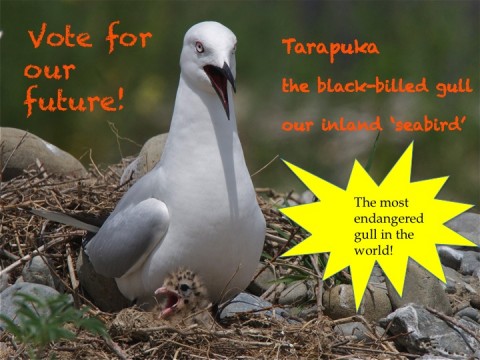Threatened species get together down at the river
A new black-billed gull/tarapunga colony has been discovered; it’s great news but because these gulls are so rare, we can’t just leave them to the mercy of predators. The campaign manager for the black-billed gull/tarapunga, Steve Attwood, gives us this update.
THREATENED SPECIES GET TOGETHER DOWN AT THE RIVER
Braided river birds are getting it together in Canterbury with Environment Canterbury (ECan) reporting that a nesting colony of tarapuka (black-billed gull) has established on the Waimakariri River alongside nesting tara (white-fronted tern), tarapiroe (black-fronted tern) and ngutupare (wrybill).
Tarapuka, with a conservation status of ‘”nationally critical”’ are the world’s most endangered species of gull. Tarapiroe arend nationally endangered and ngutupare, the only bird in the world with a bill that bends sideways, are ‘”nationally vulnerable’”. The tara, while New Zealand’s most common tern, is declining and authorities are concerned for its future.
Niall Mugan, ecologist and ornithologist, reports that there are two black-billed gull colonies on the Waimakariri with the largest, which is the one associated with the other river-breeding birds, having about 700 gulls in residence along with approximately 200 white-fronted terns, 30 pairs of black-fronted terns and several pairs of wrybill.
Mugan notes that while the colony is great news, what is not so good is that there seems to be high numbers of predators in the area, particularly introduced mammalian predators against which the ground-nesting birds have few defences. He says initial trapping set up around the colony has caught several pests, including stoats and a ferret.
Predator pressure aside, Mugan says he believes the colony site is the best location the gulls have chosen in five years of surveying the Waimakariri and he has high hopes for a successful year.
VOTE BLACK-BILLED GULL FOR SEABIRD OF THE YEAR: www.seabirdoftheyear.org.nz

